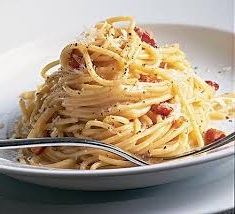The Ultimate Spaghetti Carbonara Recipe: Authentic, Creamy, and Irresistible
If you're a lover of Italian cuisine, few dishes deliver the comfort, flavor, and satisfaction quite like a classic Spaghetti Carbonara. Rich, creamy (without using cream), and packed with bold, savory flavor, this Roman masterpiece has earned its place as a favorite on dinner tables around the world.
In this article, we present the Ultimate Spaghetti Carbonara Recipe, crafted for both authenticity and taste. Whether you're a kitchen novice or an experienced home chef, this guide walks you through everything you need to make the perfect carbonara—every time.
🥄 What Is Spaghetti Carbonara?
Spaghetti Carbonara is a traditional Italian pasta dish originating from Rome. It’s known for its luxurious yet simple sauce made from eggs, Pecorino Romano cheese, guanciale (cured pork cheek), and black pepper. What makes carbonara unique is its creamy texture—created entirely without the use of cream or butter.
The heat from freshly cooked pasta gently cooks the egg and cheese mixture, transforming it into a velvety sauce that clings to every strand of spaghetti.
🍝 Ingredients: Quality Is Everything
To make the ultimate spaghetti carbonara, you need just a few ingredients—but they must be high-quality. Here’s what you’ll need:
Ingredients (Serves 4):
-
400g (14 oz) spaghetti (or pasta of your choice)
-
150g (5 oz) guanciale, diced (or pancetta as a substitute)
-
4 large egg yolks + 1 whole egg
-
1 cup (about 100g) Pecorino Romano cheese, finely grated
-
Freshly ground black pepper
-
Salt (for pasta water)
✅ Pro Tip: Stick with guanciale for an authentic Roman flavor. It has a rich, porky taste that crisp bacon or pancetta can’t fully match, though those are acceptable substitutes in a pinch.
🧑🍳 Step-by-Step: How to Make Spaghetti Carbonara
Making carbonara is all about timing, heat control, and the perfect emulsion of cheese, egg, and pasta water. Follow this guide carefully:
Step 1: Prep Your Ingredients
-
Grate your cheese.
-
Separate your eggs—use 4 yolks and 1 whole egg for a balance of richness and silkiness.
-
Dice the guanciale into small cubes or strips.
Step 2: Cook the Pasta
-
Bring a large pot of salted water to a boil.
-
Add the spaghetti and cook until al dente (firm to the bite).
-
Reserve at least 1 cup of pasta water before draining—this is key to creating the sauce.
Step 3: Crisp the Guanciale
-
While the pasta cooks, heat a skillet over medium heat.
-
Add the guanciale and cook until it’s golden and crispy (about 5–7 minutes).
-
Remove from heat but keep the rendered fat in the pan—this adds essential flavor.
Step 4: Mix Eggs and Cheese
-
In a bowl, whisk the egg yolks, whole egg, grated Pecorino Romano, and a generous amount of freshly cracked black pepper.
-
Add a small splash of hot pasta water to the mixture while whisking to temper the eggs slightly.
Step 5: Combine Pasta and Sauce
-
Add the drained pasta to the skillet with the guanciale and toss to coat in the fat.
-
Remove the pan from direct heat (this is crucial—too much heat will scramble the eggs).
-
Slowly pour the egg and cheese mixture over the pasta, tossing quickly and consistently to create a creamy sauce.
-
Add small amounts of reserved pasta water as needed to reach the perfect creamy consistency.
Step 6: Plate and Serve
-
Serve immediately, topped with more grated Pecorino and a generous twist of black pepper.
✅ Chef's Note: The sauce should be silky and coat the noodles beautifully—not dry or watery, and certainly not scrambled.
🧂 Carbonara Tips & Tricks
🔥 Don’t Overheat the Sauce
The most common mistake is scrambling the eggs. Always remove the pan from the heat before adding the egg mixture.
🧀 Choose Real Pecorino Romano
Authentic Pecorino Romano is sharp and salty, perfect for balancing the richness of the eggs and guanciale.
💧 Use Pasta Water Wisely
Starchy pasta water acts as a natural thickener and helps emulsify the sauce. Add it in small amounts for perfect texture.
🥓 Substitutions & Variations
While purists insist on authenticity, here are a few acceptable tweaks:
-
Guanciale Substitute: Use pancetta or thick-cut bacon if guanciale isn’t available.
-
Cheese: Parmigiano-Reggiano can be used in place of or alongside Pecorino for a milder flavor.
-
Pasta: While spaghetti is traditional, bucatini, fettuccine, or rigatoni also work well.
⚠️ Avoid Adding Cream or Garlic: These ingredients are common in Americanized versions but stray from the traditional Roman recipe.
🍷 Pairing Suggestions
The richness of carbonara pairs beautifully with crisp, acidic wines that cleanse the palate:
-
White Wine: Pinot Grigio, Verdicchio, or Sauvignon Blanc
-
Red Wine: Light reds like Chianti or Barbera
-
Non-Alcoholic: Sparkling water with lemon or a crisp apple cider
🇮🇹 A Brief History of Carbonara
The origin of spaghetti carbonara is widely debated. Some believe it dates back to Roman shepherds who created a simple dish using preserved pork and pasta. Others suggest it gained popularity after World War II, when American soldiers brought eggs and bacon to Italy.
Regardless of its roots, carbonara has become a cornerstone of Italian cooking and a beloved staple in kitchens worldwide.


You must be logged in to post a comment.